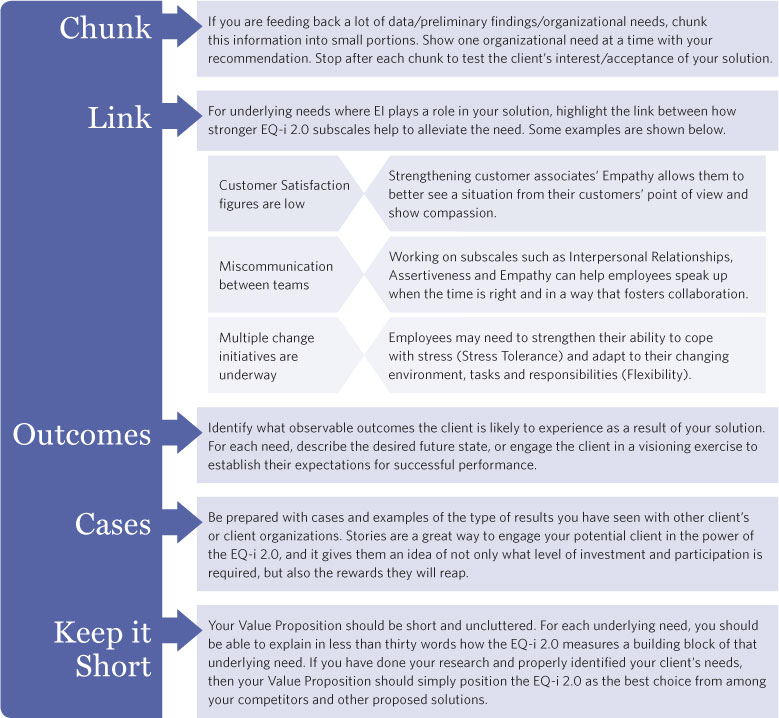Part II: Administering a Self-Report EQ-i 2.0
Planning the EQ-i 2.0 Assessment Process
Step 2: Communicating the Value in EI
Once underlying needs have been identified, the value for the client is in seeing how EI can be part of the solution for resolving their needs. In many cases, either a personal or organizational need can be distilled to one of the emotional and social skills measured by the EQ-i 2.0. That’s why the fifteen subscales are often referred to as building blocks. By showing how a client’s need rests on these EI building blocks, you can make clear, theoretical connections between the EQ-i 2.0 and the needs that a client wishes to resolve the most. Some examples are shown in Table 4.2.
Table 4.2. Communicating the Value of EI
| Common Organizational Department/Team Needs | How the EQ-i 2.0 is Connected |
|---|---|
| Too many costly and unsuccessful hires | When EI is related to high performance the EQ-i 2.0 can be integrated into the selection process to make better hires |
| Leaders are unequipped to handle change | At the root of managing change and inspiring others through tough times, leaders must first manage their own emotions associated with change (Emotional Self-Awareness, Emotional Expression) |
| New products are being developed | Although analysis and decision making around new products will typically involve data, it will also require decision makers to let go of their personal attachment, solve problems using both hard and emotional data and resist rash decisions (Reality Testing, Problem Solving and Impulse Control) |
| Leaders shy away from healthy conflict | Conflict Management skills can be addressed by zeroing in on elements such as Impulse Control, Assertiveness and Self-Regard so that leaders manage conflict in a way that is healthy and constructive |
| I’m looking to make a career transition | Because all jobs require some degree of emotional and social functioning, knowing how EI strengths align to future career possibilities will help inform your client’s career transition plan and ensure they work on EI development goals that better position them for the career they want. |
| I want to build stronger relationships | In both personal and professional spaces individuals need to understand how well they maintain positive relationships, show care and concern for others and demonstrate oneself as a contributing member of one’s social group (Interpersonal Relationships, Empathy and Social Responsibility). |
| I don’t know my strengths or weaknesses | Because the EQ-i 2.0 measures an array of social and emotional skills that underpin a whole host of other competencies, the assessment is a good, non-threatening place to start this conversation and subsequent coaching |
| I want to succeed at university | Much research has shown that students who have well developed EI perform better in higher education. Specific areas that may derail your client’s university career can be examined and addressed before they become issues |
A best practice from coaches and consultants who work with the EQ-i 2.0 in organizations is to create a value proposition which communicates the value in adopting the EQ-i 2.0. It is a conversation or a document that summarizes all the information you uncovered about a client’s needs and makes clear links to how the EQ-i 2.0 may be a viable solution in addressing those needs. Keep in mind a Value Proposition can only be effective if you have correctly identified the client’s needs in the first place. If it is possible to do so, validate the needs you have identified against sources within the organization before you take the step of recommending solutions.
Your Value Proposition should be created using the best practices illustrated in Figure 4.2.
Figure 4.2. Best Practices in Creating Your Value Proposition
